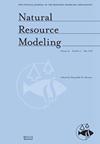A soft systems methodology and interpretive structural modeling framework for Green infrastructure development to control runoff in Tehran metropolis
IF 2.1
4区 环境科学与生态学
Q3 ENVIRONMENTAL SCIENCES
引用次数: 4
Abstract
Green Infrastructure Development (GID) is a well‐known method for dealing with runoff control and mitigating the urbanization effects on hydrological cycles. Other than hydrological factors, GID is obviously intertwined with many socioeconomic, environmental, and aesthetic considerations, constraints, and drivers. Human perceptions are valuable resources to distinguish these considerations and can be derived from unstructured information using a systematic method. The purpose of this article is to exhibit how the perceptions of stakeholders were derived in Tehran for a conceptual model of green infrastructure development. For this, we applied a combination of Soft Systems Methodology (SSM) and Interpretive Structural Modeling (ISM). The results revealed the main stakeholders, their relationships and responsibility, main obstacles for GID, and the conceptual system of activities for GIs development in Tehran. Based on the results, actions for improving the current situation were proposed and categorized in 10 main components including: further research, regulation, financial support, negotiation with stakeholders, evaluation and monitoring, enhancing stakeholders' interactions, providing comprehensive database, acculturalization, managerial reform, and training of stakeholders. ISM was performed to obtain a visible, ordered, and well‐defined model of the relationships among the main components. The results revealed that the item “further research” plays the main role in actualizing three components “regulation,” “financial support,” and “negotiation with stakeholders” in the process of GID in Tehran while the realization of the rest of the components depends on the former three components.德黑兰大都市控制径流的绿色基础设施开发的软系统方法和解释性结构建模框架
绿色基础设施开发(GID)是处理径流控制和减轻城市化对水文循环影响的一种众所周知的方法。除了水文因素外,GID显然与许多社会经济、环境和美学因素、制约因素和驱动因素交织在一起。人类感知是区分这些考虑因素的宝贵资源,可以使用系统方法从非结构化信息中得出。本文的目的是展示德黑兰利益相关者对绿色基础设施发展概念模型的看法。为此,我们将软系统方法论(SSM)和解释结构建模(ISM)相结合。结果揭示了主要利益相关者、他们的关系和责任、全球信息发展的主要障碍以及德黑兰全球信息发展活动的概念体系。根据研究结果,提出了改善现状的行动,并将其分为10个主要组成部分,包括:进一步研究、监管、财政支持、与利益攸关方谈判、评估和监测、加强利益攸关方的互动、提供全面的数据库、文化融合、管理改革和培训利益攸关方。执行ISM是为了获得主要成分之间关系的可见、有序和明确的模型。结果表明,在德黑兰GID过程中,“进一步研究”项目在实施“监管”、“财政支持”和“与利益相关者谈判”三个组成部分中发挥着主要作用,而其余组成部分的实现则取决于前三个组成部分。
本文章由计算机程序翻译,如有差异,请以英文原文为准。
求助全文
约1分钟内获得全文
求助全文
来源期刊

Natural Resource Modeling
环境科学-环境科学
CiteScore
3.50
自引率
6.20%
发文量
28
审稿时长
>36 weeks
期刊介绍:
Natural Resource Modeling is an international journal devoted to mathematical modeling of natural resource systems. It reflects the conceptual and methodological core that is common to model building throughout disciplines including such fields as forestry, fisheries, economics and ecology. This core draws upon the analytical and methodological apparatus of mathematics, statistics, and scientific computing.
 求助内容:
求助内容: 应助结果提醒方式:
应助结果提醒方式:


